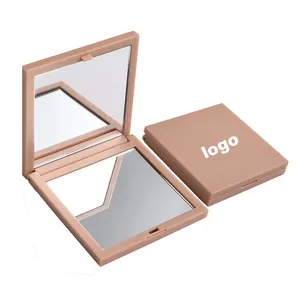

Custom Logo Portable Small Travel Square Personal Foldable Small Plastic Vanity Mirror Handheld Pocket Mini Makeup Mirror


New Design Custom Logo Small Hand Square Makeup Mirror Compact Led Lighted Pocket Cosmetic Mirror With Light





















A beveled mirror is a flat mirror whose edges have been cut and polished to a certain angle and size. The middle retains its regular 1/4-inch thickness, but the mirror becomes thinner at the edges as a result of this process. Large bevelled mirrors create an angeled surface cut around the mirror's perimeter. The angled surface is generally approximately 1 inch wide. The bevel acts as a prism that refracts light, splitting it into the various colors of the rainbow. A bevelled edge mirror has edges that are slightly slanted or inclined. The bevel's angle is determined by the overall design of the mirror. The edges appear more inclined the steeper the bevel.
Framed bevelled mirrors can add a decorative touch to any room in a home. Aside from the edges of a bevelled mirror wall, there isn’t much difference between a flat mirror and a beveled mirror. While they both reflect the same amount of light, beveled mirrors give a very luxurious and glamorous look to any space. The edges of these frameless bevelled mirrors are cut at specific angles, which provides an impression of them being framed (though they may not have any framing at all). This stylistic edge highlights the mirror design and gives it a distinctive look. Additionally, they are ground and polished on the edges; they do not have a sharp edge, making them safer to handle. Since bevelled bathroom mirrors can reflect and retract light better, they also provide a sense of depth to any bathroom they are placed.
Bevelled glass mirrors can be ¼", ½," ¾," 1", one ¼" or 1 ½" wide, and most commonly either ½" or 1" wide. Bevels are carved straight into the mirror's surface. Beveled strips are another common choice; these are attached to the mirror's face. Bevel strips are generally 2", 4", or 6" wide, with ½" wide bevels on two edges. These bevel strips are often referred to as bevel overlays because they are adhered to the surface of a mirror or overlaid on the surface of a mirror. They commonly create a raised border around the mirror's perimeter. Modern beveled glass is made by running the glass or mirror on a conveyor belt through the beveling machine, with either a straight-edge beveler or a shape beveler. These machines have grinding wheels with varying grits. As the glass moves along the machine, the grits become ever finer until the last grinding wheel puts a high polish on the glass.